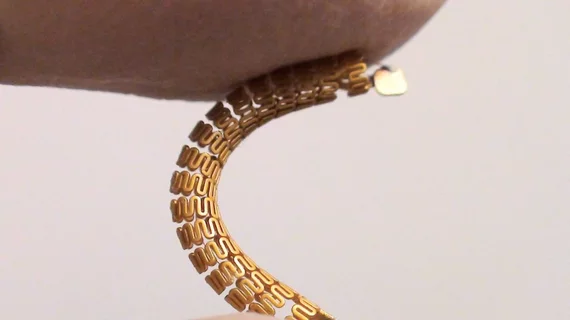Researchers at the University of British Columbia have developed a “smart stent” that can monitor hemodynamic changes in the artery and warn clinicians of restenosis at its earliest stages.
They recently published their progress with the technology in Advanced Science, detailing results of bench delivery testing with different stent diameters and the successful implantation of the device in a pig.
“We modified a stent to function as a miniature antenna and added a special micro-sensor that we developed to continuously track blood flow,” Kenichi Takahata, PhD, a professor of electrical and computer engineering at UBC who developed the stent, said in a press release. “The data can then be sent wirelessly to an external reader, providing constantly updated information on the artery’s condition.”
The sensor chip is small enough to work with standard catheterization procedures and is made of biocompatible materials. It is able to be implanted using existing balloon catheters, making it the first angioplasty-ready smart stent, according to the researchers.
York Hsiang, MBChB, MHSc, a vascular surgeon at Vancouver General Hospital and one of the authors of the study, believes the technology could simplify the process of monitoring for restenosis, a common complication of percutaneous coronary intervention.
“X-rays such as CT or diagnostic angiograms, which are the standard tools for diagnosis, can be impractical or inconvenient for the patient,” Hsiang said. “Putting a smart stent in place of a standard one can enable physicians to monitor their patient’s health more easily and offer treatment, if needed, in a timely manner.”
Takahata said his team will further refine the device and look to test it in clinical trials before seeking commercial approval.
“The technologies of robust electromechanical integration and biocompatible packaging developed for the current device can benefit the development of other types of smart medical implants,” the researchers wrote.

